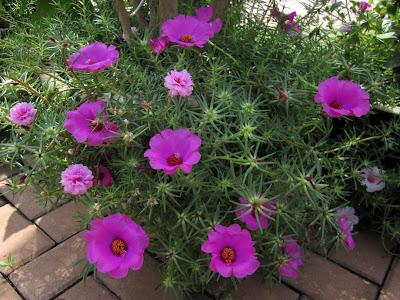A pot fully draped with portulaca grandiflora of the brazilian variety. Their blooms are large averaging about 2" in diameter compared to the usual ones.
Two varieties, the white & pink bicolour and the fuchsia grace the rim of a pot of bougainvillea
These are real eye candy. This intense fuschia colour is most attractive and would brighthen up any garden
They are sun worshippers but will wilt if the heat gets too strong by late afternoon. The blooms last a day but they will always be a fresh crop the next day.
Curiously the stigma is positioned towards the side and bottom of the whole mass of stamens. Towards the later part of the day the pollen pods would burst and scatter its contents. However the easier and preferred method of propagating is by stem cuttings. Simply just nick some thick stems and push them into some rich soil. No rooting hormone is needed at all; they practically thrive like weeds. In about two days they'll look fine and dandy with sturdy blooms.
Delicate petals flutter with the softest of breeze
An unlikely mix of both types is seen on this particular flower
The double petal flowers are smaller
A swath of double petal blooms.
Portulaca are also commonly called moss rose or Japanese rose
 the purest white
the purest white
 powder pink
powder pink
two toned variety of white and pink
peachy and pretty
orange ones grab the eyes
peach colour with blushes of pink
Fuchsia ones are the original portulaca colour
Poopoo scoop for Tasha, my chihuahua mix-breed on a bed of Portulaca
Tasha sporting a portulaca bloom behind her ear









































